Jungles and Wetlands India 2018 & 2023!
Jungles and Wetlands of India
Led by Steve Race and Richard Baines
Wildlife Trip Report Nov 25 – Dec 8 2018.
In November 2018 Yorkshire Coast Nature together with Indus Experiences ran a fabulous trip to India. This is a great time to re-live those experiences as we have a new trip to India in February 2023 all ready for booking, to see all the details CLICK HERE.
This is my day to day journal of unforgettable wildlife encounters.
Our tours are designed for wildlife enthusiasts, birders and wildlife photographers. All of our trips are designed to give an immersive, richer experience, we don’t rush around trying to see as many species as possible. We choose two or three destinations and spend enough time in each place to be able to learn about the wildlife and their habitats, get to know the local guides and ‘drink in’ these amazing places.
Day One
Flying from Heathrow to Delhi overnight is by far the best option, no stop overs and chance to have a sleep on the plane not to mention the back-seat movies! We arrived in Delhi at 0900 and headed straight for a couple of hours in Lodhi Garden. Almost spotlessly clean, this beautiful park in central Delhi is a surprisingly good birding and photography destination. One Pecan tree was dripping with birds swallowing its ripe fruit; Coppersmith Barbet, Brown-headed Barbet, Asian Koel, Indian Grey Hornbill and Yellow-footed Green Pigeon were all having a feast whilst Hume’s Warblers, Oriental White-eyes and Purple Sunbirds zipped in and out in search of insects. Nearby, Indian Pond Heron, Little Cormorant and White-throated kingfishers chilled out by the side a small pond and a Small Indian Mongoose ran along a nearby wall, great wildlife amongst visiting local families soaking up the natural scene.
Black Kites soar above the park and roost in the dead trees. Whilst they can be seen in many places in India they show particularly well here and create a photogenic medieval scene dropping onto the grass by the side of historic temples. After a tropical urban bird rush, we needed to catch the train and head north to Ramnagar, the closest station to the vast Corbett National Park
Day Two
We usually start our first full day with Jungle Jims (JJ’s) ‘garden’ birding. A relaxed morning after a long journey. This though is garden birding with a difference. JJ’s is located adjacent to some great jungle habitat. Not every garden has the following list of birds to boast after a late breakfast; Cinerous Vulture, Himalayan Griffon, Red-headed Vulture, Oriental Honey Buzzard, Shikra, Indian Thicknee, Blue-bearded Bee-eater and numerous songbirds. Amongst which I found two Whistler’s Warblers a new bird for me and the first ones to be seen here for several years. After a delicious lunch we climbed aboard the jeeps for our first game drive.
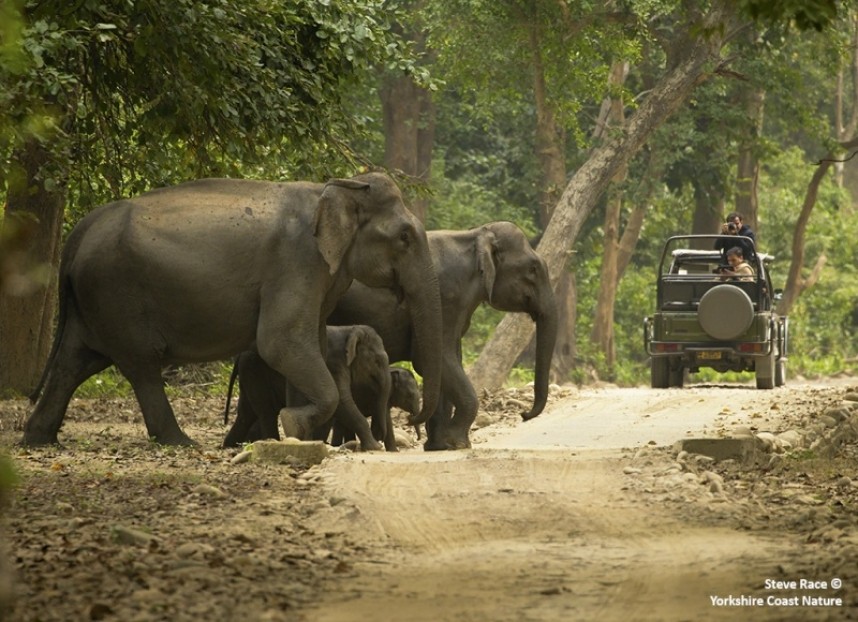
Asian Elephant family in Corbett NP © Steve Race
A short drive, and we were into Corbett NP. The grassland habitat on this drive is always productive. Black-winged Kites sat by the roadside alongside Southern Grey Shrike and Long-tailed Shrikes whilst every small shrub seemed to have either a Pied Bushchat, Siberian Stonechat or Common Stonechat or a Grey Bushchat perched on top. One of our highlights here was a beautiful Red-necked Falcon which sat obligingly for everyone atop a tree. After chi and a short break, we rumbled off into the grassland again in search of large mammals. Within 15 minutes we came upon a family group of Asian Elephants guarded by a teenage female. Half a mile away we found the big Tusker dwarfing the tall grasses, regularly smelling the air with his trunk and emitting one big bellow which seemed to shake the ground beneath us! A big red sun set over the forest as we headed back to JJ’s with rosy cheeks and big smiles.
Day Three
The Kosi River flows from the high Himalaya down through Corbett NP. This vast floodplain feeds a huge area of forest and agricultural land sustaining both people and wildlife. On the third day we set out early morning in our jeeps and headed straight for the river. Within minutes we were watching four species of Kingfisher; a huge Crested Kingfisher, Pied Kingfisher, White-throated Kingfisher and Common Kingfisher. The riverside habitats ideal for photography and birding.
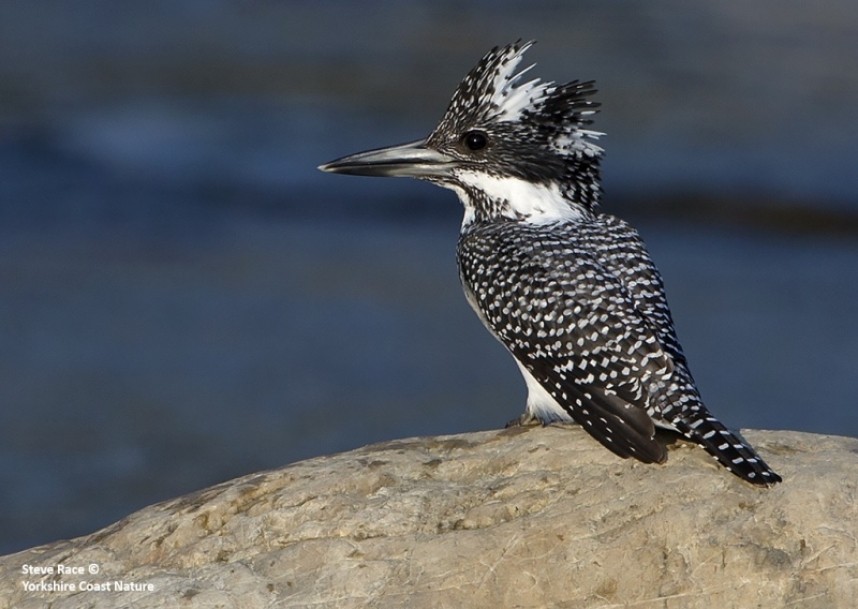
Crested Kingfisher on the Kosi River © Steve Race
Alongside the Kingfishers were River Lapwings, White-capped Water Redstart, Plumbeous Redstart and Wallcreeper. We set up our group stake out by the river adjacent to a stony and short grassland floodplain. I really like this area as it attracts migrant pipits and other songbirds navigating up and down the river. Whilst watching a distant Wryneck I picked up a pale upright passerine on the rocks. With the help of our guide Manoj Sharma we identified it as a Red-tailed Wheatear, only the third record for the state of Uttarakhand! Nearby were Rosy Pipits, Paddyfield Pipit and Long-billed Pipit and further away a Collared Falconet sat sentinel like atop a dead tree.
After such a great morning birding we set off after lunch for Tumaria Reservoir with high hopes of more great birds. The heavy monsoon earlier this year had filled the reservoir creating perfect habitat for waterfowl. In the fields and overhead were big numbers of Red-naped Ibis, on the water over 2,000 Common Pochard were joined by Ferruginous Ducks and many other species in a large raft of duck. A detailed look at a group of Great Crested Grebe revealed a Black-necked Grebe. This was a mega bird for the state of Uttarakhand with very few records. Amongst many other water birds on the nearby marsh were both Pheasant-tailed Jacana and Bronze-winged Jacanas.
Day Four
Back into the jungle on day four with two back to back game drives. Checking into the NP is a strict affair with passports required at each gate. A process which is not only necessary to protect this wonderful place but also exciting, adding to the anticipation. With four jeeps its always a lottery who sees what, only five minutes between us and we often see different things. Today was no different as our combined mammal list boasted Bengal Tiger, Golden Jackal, Wild Boar, Nilgai, Samba Deer, Spotted Deer, Barking Deer and a big bellowing herd of Asian Elephants. There were lots of happy cameras and aww noises from our group as a tiny two-month-old Asian Elephant strode across our track sticking tightly to its mothers’ side.
Birding in the Indian jungle in winter is no different to many other places in the world, the key is to find the foraging flocks. After a quiet hour we came upon a big flock with many species. Each species took up its own structural niche. Bar-winged Flycatcher Shrikes, Maroon Orioles and Long-tailed Minivets in the canopy, Lemon rumped Warblers and Velvet-fronted Nuthatches in the branches below, Fulvous-breasted Woodpeckers and a Racket-tailed Drongo in the mid and lower levels. Add to that Great Hornbill and Oriental Hornbill a short distance away.
Afternoon and evening were spent in the Bijrani zone a wonderful mixture of dry streams, grassland and forest. A Snowy-browed Flycatcher gave good views to some but eluded others in the jungle half light whilst in the open clearings Lesser Yellownape and Black-rumped Flamebacks searched for insects on the dead trees. A lucky last-minute sighting of two Bengal Tigers by one jeep included one climbing a tree, unusual behaviour and a real treat.
Day Five
Our last game drive early morning. We headed straight for the grasslands and forest in Dhela Zone. This and the nearby Jhirna Zone have become my favourite zones in Corbett for the number of birds in the grasslands and the presence of iconic species such as Great Hornbill. I fondly remember a close encounter with two Sloth Bears here In November 2017. This year the Great Hornbills didn’t let us down with 12 birds seen at various times in the morning. Their huge size and wide slow wing beats create an impressive downdraft sound in a similar way to swans. The grassland was once again alive with birds from Chestnut-tailed Starlings and Brahminy Starlings to Black-winged Kites. A Jungle Cat swaggered down one of the grassland tracks and a family of Wild Boar snuffled in the forest.
In the afternoon we split the group in two, one travelling to the Kosi Bridge and nearby forest and four of us birding at JJ’s in the grounds. The JJ gang were soon drooling with admiration as we found a Rufous-bellied Niltava sat motionless on a branch. What a stunner! Nearby the small foraging flock of songbirds allowed everyone to get more views and time with Greenish Warblers, Lemon-rumped Warblers, Grey-hooded Warblers and Yellow-bellied Fantails. The superb habitat in the grounds went on to provide Jungle Owlet, Himalayan Griffon Vultures and at dusk a Long-tailed Nightjar.
Day Six and Seven
Day six was a day of travel back to Delhi prior to moving on to Agra. Travelling in India is never boring. The train and car journeys we took allowing many opportunities for birding. Painted Storks in the fields by the train track alongside Egrets and wintering waders such as Black-winged Stilts. A group of seven Egyptian Vulture drifted over the motorway as Indian Rollers and Black-winged Kites perched on roadside wires.
We arrived at the magnificent Taj Mahal on day seven. A human rainbow greeted us at the gates as many hundreds of Indians que in their best colours. The Taj in its marble white and grey, outshone by a river of saris rippling towards its four towers. Our guide Ashok entertains us with his tales of love, pain and amazing dedication in the build of one of the seven wonders of the world.
Our visit this time was extra special as one of our party decided to propose to his girlfriend against the backdrop of the Taj. A big secret until it happened, Steve and I had to keep quiet about his plans. Thankfully she accepted and a big cheer went up from our group and a gathering of Indian school children nearby who suddenly realised what just happened, a very moving and romantic moment.
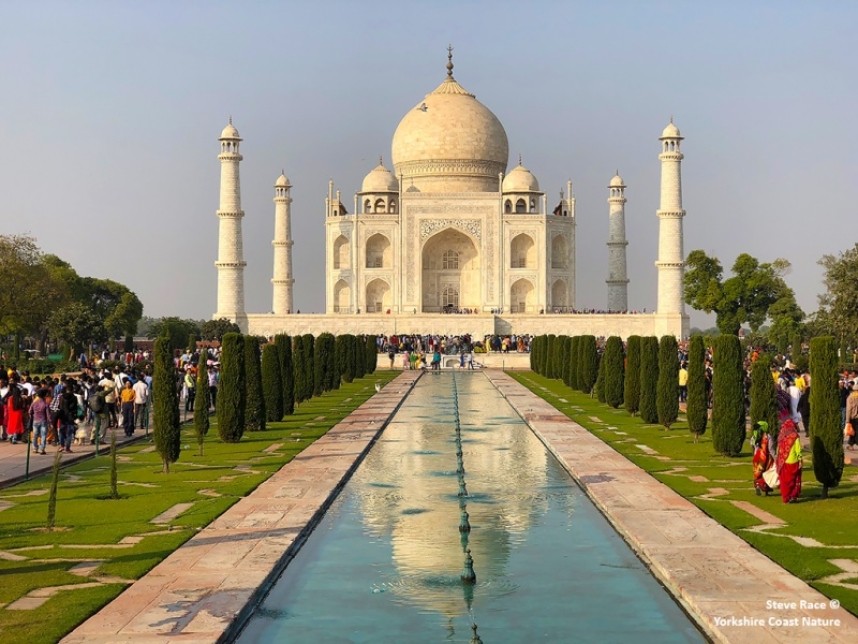
The Taj Mahal © Steve Race
The Taj is built on the banks of the Yamuna River. In winter its often teeming with water birds and it was no different on this visit. Great White Pelicans, Spoonbills, Ruddy Shelducks, Great Cormorants and hundreds of waders including big flocks of Ruff, Black-winged Stilts, Green Sandpipers and Common Sandpipers, Temmincks Stints and Greenshanks. As we were watching the river, to our left hundreds of Little Swifts swarmed over the temple and a Peregrine flew past us. It landed on one of the steel rings on the Taj dome and watched menacingly the flocks of Bank Myna’s gathering below us performing their acrobatic ritual jumps prior to roost.
Day Eight
Our first day in Bharatpur and Keoladeo National Park. Every year we use excellent local guide Brijendra Singh to help us on our journey. His knowledge of not only the birds but also of dragonflies, butterflies and plants is amazing, he is a true expert. 2018 has been an excellent autumn in Keoladeo, the heavy monsoon has re-invigorated the park and brought back thousands of water birds to breed and over winter. The biggest and craziest looking of these is definitely the Painted Stork. Well named for their riot of colour, they breed in low trees surrounded by water thus reducing the risk of predation. Last year we saw around 30 birds, this year there are thousands! Among the Storks are big numbers of Herons, Ibis, Cormorants and Great White Pelicans in fact there are few water bird species which are not here, it’s a photography and birders dream!
Whilst monster water birds deck the trees, secretive herons and songbirds hide under nearby bushes. On our first afternoon we found Striated Heron, Black Bittern and Yellow Bittern in dark tangled places. Whilst I was peering under a thorny briar looking for Bitterns, a Bluethroat popped its head out! It seems like every available niche is occupied. In the sky above the wetland there are always large raptors circling, within 30 minutes of entering the park we had seen Greater Spotted Eagle, Egyptian Vulture, Eurasian Marsh Harrier and Black Kite. This was all a great introduction for our group, they were blown away by how close everything was and looking forward to spending a whole day at Keoladeo on day nine.
Day Nine
A full day at Keoladeo National Park and the entrance only 5 minutes from our hotel, birding and photography doesn’t get much better. We stepped on to our rickshaws at 0650 and ten minutes later we were watching 24 Egyptian Vultures roosting on a dead tree at only 200m range! The raptors certainly stole the early show. By lunch time we had seen six species of eagle; one Steppe Eagle, nine Greater Spotted Eagle, one Indian Spotted Eagle, two Crested Serpent Eagle, one Booted Eagle and three Eastern Imperial Eagle. The wonderful thing about Keoladeo is many of these eagles were sat in trees allowing excellent views. Brijendra Singh was always on hand to talk through the finer details of eagle identification, a great learning experience.
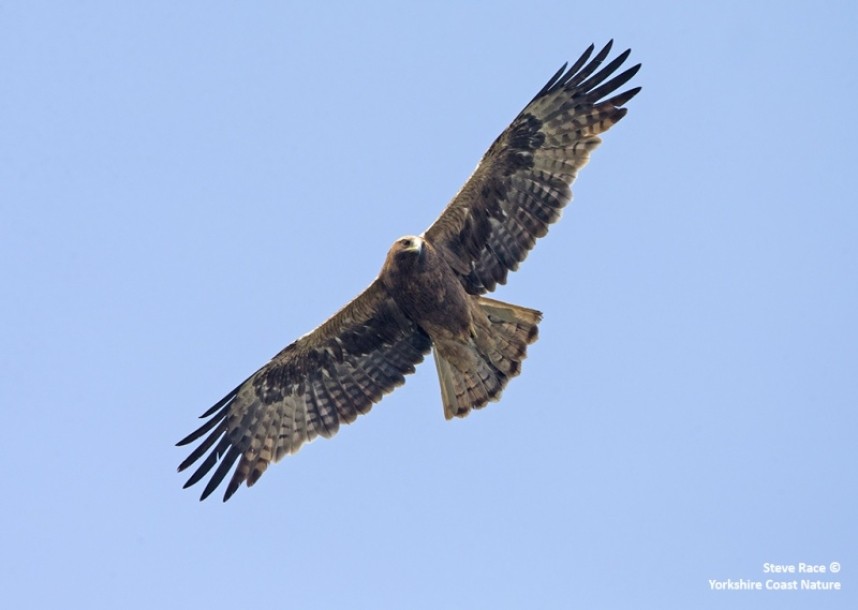
Booted Eagle at Keoladeo NP © Steve Race
Just before lunch news came through of three Sarus Cranes, so we headed for another part of the wetland, but as is often the case here you can’t go anywhere fast as there are so many distractions, we had to get past hundreds of water birds and eagles first! The Sarus family were two adults and a juvenile born this year, all digging up up plant roots with their strong bills on the edge of a tall grassland. The worlds tallest flying bird looked magnificent in the wild wetland landscape. Nearby, a Bay-backed Shrike dashed about a Tamerisk bush.
Lunch at centre point is not necessarily a break from wildlife encounters. Two Hoopoe fed on the grassland at close range and flocks of Painted Stork circled overhead. In amongst the Painted Storks were more Eagles and a spectacular Black-necked Stork.
After lunch a short stroll took us two hours there was so much to see. A tree dripping with Indian Fruit Bats was a great sight and surprisingly noisy as several individuals scrapped for the best position in the tall palm. A short distance away Painted Storks, Eurasian Spoonbills and Asian Open-billed Stork occupied their nests feeding young at very close range whilst in the sky above, flocks of Great White Pelicans soared on the warm thermals. Bluethroats put on a good show today seemingly in every bush along with Plain Prinia, Ashy Prinia, Clamorous Reed Warblers, Lesser Whitethroats, Greenish Warblers, Humes Warbler, Blyth’s Reed Warbler, Red-breasted Flycatcher and one Red-throated Flycatcher.
Day Ten
Chambal River flows 960km from the Vindhya Range in Madhya Pradesh to Uttar Pradesh. Our boat trip in 2017 was so good we included it on this year’s itinerary in the hope it could produce again. Our main targets were Indian Skimmer, Black-bellied Tern and the Crocs! The small boats are ideal for birding and photography, our group split into two boats ensuring enough room for everyone and we were down low to the water for the best photographic opportunities. Before we boarded there was an opportunity to enjoy Wire-tailed Swallows at close range and a monster Great Thicknee roosting close to the jetty. Within 10 minutes of being on the boat we found two Indian Skimmers roosting on the sand spit, alongside a River Tern. Nearby Kentish Plover, Temmincks Stint and Little Plover fed on the shoreline.
As we sailed down river, we left the bridge and the sound of traffic behind and entered a beautifully soft and peaceful landscape of sand cliffs, gently sloping fields and the serene calm of the Chambal River. It was such a joy to simply chug slowly along on the lookout for wildlife. A short time after the Skimmers we sighted a Short-toed Eagle and many Tortoise resting on the side of the river. Nearby was our first Mugger Crocodile, a juvenile, posing with its snout held aloft in a manner typical of an indignant teenager! Across the other side of the river were the famous Gharial or Fish-eating Crocodiles. We counted 11 individuals from very small youngsters to an enormous male sporting his characteristic globular growths on the end of his snout. As we were watching the Crocs a Black-bellied Tern dropped into the water by the side of our boat.
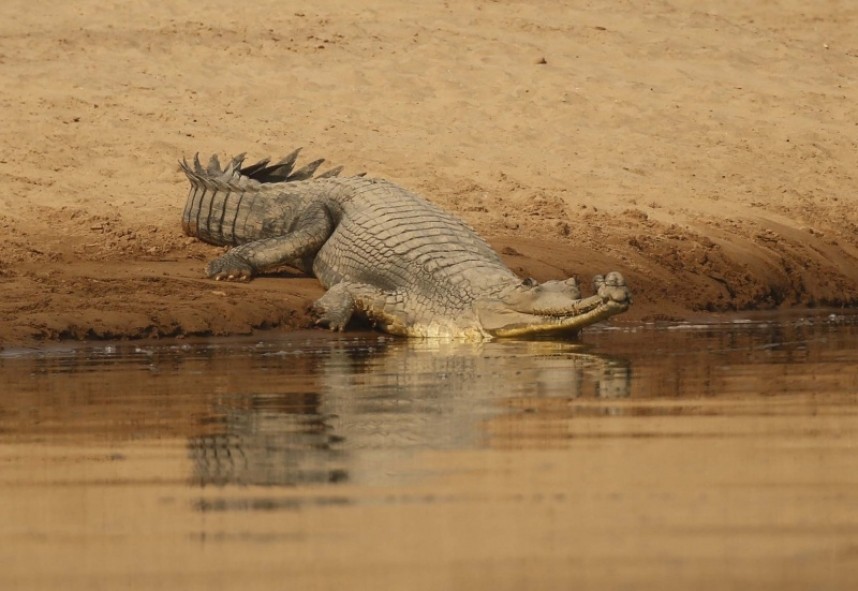
male Gharial on the Chambal River © Richard Baines
On the banks above the Crocs were Bar-headed Geese, Ruddy Shelduck and Egyptian Vultures. One of our group caught sight of a mammal trotting up the sand cliffs; a Jungle Cat showing off its striped tail and small feline head. Our last encounter with the Indian Skimmers included views of them feeding. Using their unique bill skimming skill to catch small fish, they flew with such grace and precision above the glass like water. An in town stop off at a large pond produced hundreds of Citrine Wagtail with smaller numbers of Flava Wagtails.
A late afternoon return to our base at Birders Inn, allowed time for a quick three hour rickshaw dash into Keoladeo National Park. We were well rewarded with three Little Bee-eater, seven Greater Flamingo, Great White Pelicans, Dalmatian Pelican and big numbers of water birds including thousands of Gadwall, Northern Pintail, and Eurasian Wigeon, a single male Ferruginous Duck, Indian Spot-billed Ducks and a single Cotton Pygmy Goose. On the way out of the park we watched three Golden Jackal start their evening food patrol.
Day Eleven
Our second full day at Keoladeo National Park. There are so many birds and other wildlife here it deserves far more than a short visit, there is so much to see and we always make sure we have time enough to ‘drink in’ the experience. An early morning visit to pools behind the temple area was a good site for waders with excellent views of Marsh Sandpiper, Greenshanks, Green Sandpipers and Wood Sandpipers. We searched for Orange-headed Ground Thrush almost in vain until one shot out of the undergrowth and over our heads. Joining this gorgeous bird under the bushes and on the tracks were yet more Bluethroats. This winter has seen greater numbers at Keoladeo than in recent years along with Indian Robins and Oriental Magpie Robins.
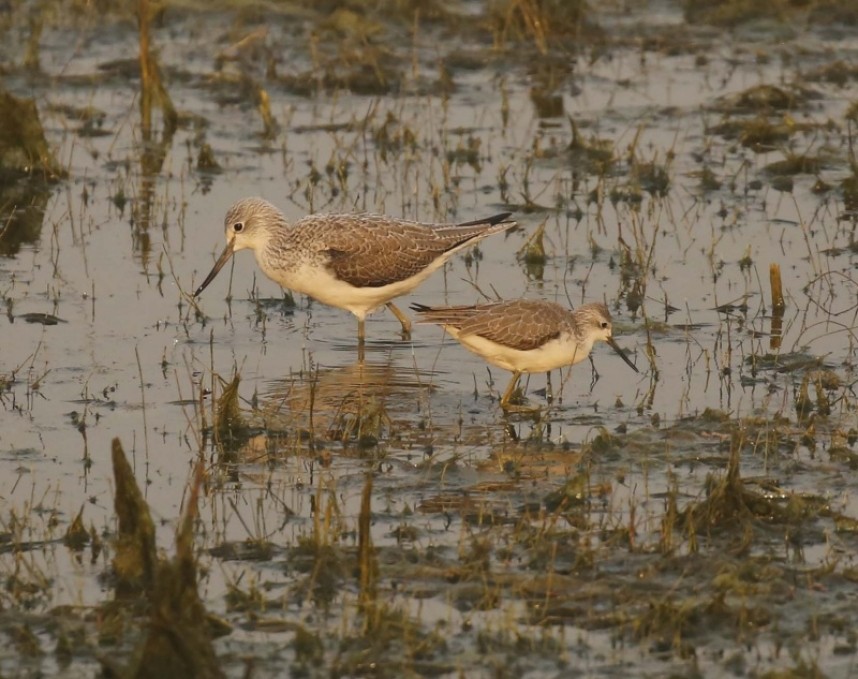
Greenshank & Marsh Sandpiper at at Keoladeo NP © Richard Baines
Moving slowly down the main causeway on rickshaws we stopped to watch a Purple Heron at close quarters, Greater Spotted Eagles, Asian Open Billed Stork and two young male Nilgai in fighting mode. Nilgai or Blue Bull are huge mammals, the biggest Antelopes in the world. These two teenagers were engaged in mock combat in the middle of the wetland with hundreds of water birds close by adding greatly to this impressive wildlife spectacle. As we walked down another track before lunch a National Park truck stopped to show us two Indian Rock Python. They had been rescued from a nearby village and brought into the Park for release. The largest snake in the truck was an adult female weighing in at 40-50kg!
From a watch tower close to the centre of the park we could see into the Painted Stork nests and watch the adults feed their young. We could also see the Black-necked Stork nest where the female was delicately tending her small chicks with her huge bill. There is only one pair of these stunning birds nesting this year, they are becoming increasingly rare at Keoladeo and throughout the Indian Subcontinent.
A late afternoon and evening stroll on the Lodge Trail where a flock of up to 50 Great White Pelican had gathered to feed, nearby seven Greater Flamingo were feeding, thousands of freshwater duck including Red Crested Pochard and Comb Duck and hundreds of Spoonbill gathered. In the nearby bushes Pied Kingfishers perched and a Bay-backed Shrike flitted around the branches. This was to be our final evening in the Park, a fitting finale as the sun went down over the trees and marshes and thousands of water birds filled the sky.
Day Twelve
Our second full day trip, this time to two locations in search of two iconic species; Indian Courser and Indian Vulture. We started with some early morning birding on a disturbed edge of arable fields near Kumher. The early start paid dividends with a great bird rush which included three species of shrike within 100m of each other; Long-tailed Shrike, Southern Grey Shrike and Brown Shrike. I can’t ever remember seeing three species of shrike so close to each other anywhere before. Nearby a very smart male Desert Wheatear, Isabelline Wheatears, Tawny Pipits, Short-toed Larks and Ashy-crowned Sparrow Larks. A short drive down the road to find open fields growing Green Gram the legume pea used in the famous Indian dish Chana Dal. These small feathery plants and the open low growing structure of the field created ideal habitat for Indian Coursers. Within minutes of getting out of the car we had seen the distinctive white head markings of the Courser. We counted 15 birds as we took up position on the edge of the field and waited patiently for them to approach for a few photographs. This was definitely worth sticking around to enjoy. As we were enjoying the Coursers 200 Short-toed Larks flew up from the field and a very noisy Large Grey Babbler kept us entertained.
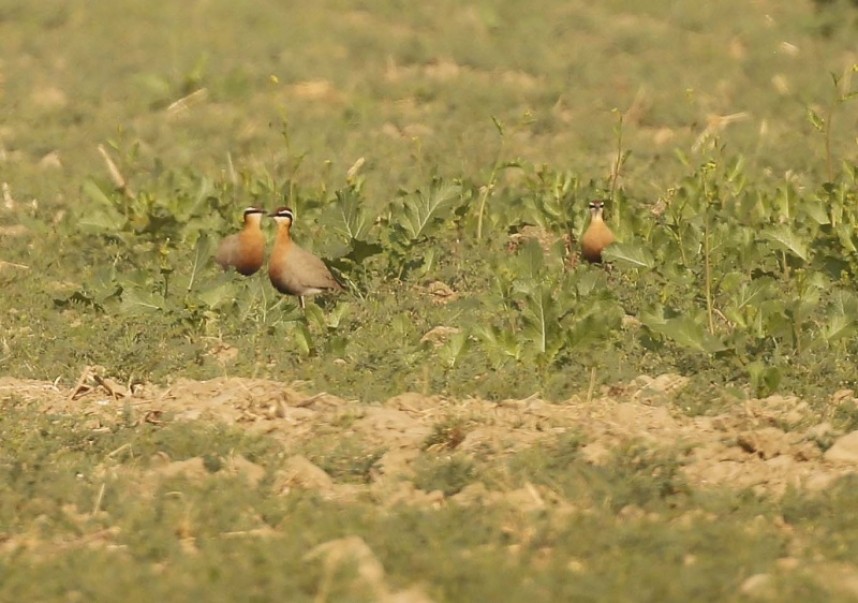
Indian Couser © Richard Baines
Band Baretha was our destination in the afternoon. I had visited this site in 2017 and been impressed with the whole experience not to mention meeting the school children and showing them the vultures through our telescopes. We were again greeted with wonderful grace by the school and served Chi as we watched the Vultures and chatted to the school master. Above the cliffs the Vultures were joined by around 20 Dusky Crag Martin, two Short-toed Eagle and a Common Kestrel. As were sipping Chi and eating our lunch a Black-winged Kite flew in and landed within 15 meters on a pole, its tail lifting behaviour indicative of a bird in active hunting mode.
Brijendra was keen to do a count of nests and individual Vultures. In the end we settled on 30 birds and 12 nests. Brijendra told us this was slightly more than in 2017 so there was a little optimism about the future of these magnificent birds.
Brijendra explained the massive steep decline in Vultures across the whole of Asia caused by the introduction of the veterinary drug diclofenac in the 1990’s. Bjindra told us he remembers seeing over 2,000 Vultures in Keoladeo National Park in the late 1980’s. Since the decline India has suffered a big rise in Rabies and other diseases, with fewer Vultures, cattle carcasses attract more feral dogs and rats. Now the drug is banned there is hope but any population recovery will be slow, and in some villages the drug is still being used. India has now started a reintroduction program determined to restore the population to previous levels. To see how you can help the scheme see this link. http://www.save-vultures.org/
Day Thirteen
Our last birding morning at Keoladeo National Park. We rose early and were greeted by a dense mist at the entrance to the National Park. This actually helped us as it meant we could keep our rickshaw wheels moving down to the water areas. We are normally distracted by so many good birds popping up by the side of the track we get delayed and never reach the wetland early in the day. As we rolled onwards the mist started to lift, burnt off by the rising sun. By the time we arrived at the first wetland area the sun had risen higher in the sky, piercing the mist and creating a soft golden light. Three Sarus Crane appeared ghost like in the mist, feeding on the edge of the tall grassland only 200m away! A great opportunity to watch the Crane family and capture some very atmospheric photos. And of course, we weren’t the only mammals in the area. A Spotted Deer swam past the Cranes and nearby a huge male Samba Deer strode ominously through the marsh.
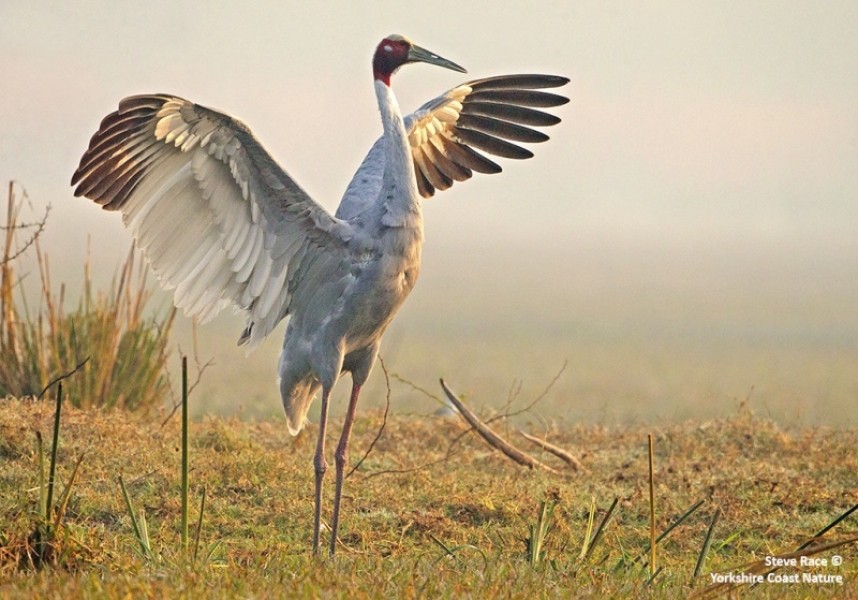
Sarus Crane at Keoladeo NP © Steve Race
A short distance away Brijendra found a roosting Oriental Scops Owl, our first of the trip. At the other end of the Owl size scale was a female Dusky Eagle Owl sat on her nest, located on the edge of the Painted Stork colony. A small flock of feeding hirundines over the marsh included four species; Barn Swallow, Streak-throated Swallow, Wire-tailed Swallow and Plain Martin. A cry of “Pelicans” went up, we looked across the wetland and saw a group of over 100 Great White Pelicans landing on the water. They started to feed voraciously, almost as one in a tightly nit flock, then as quickly as they arrived, they left like a breaking wave of wings and crashing water.
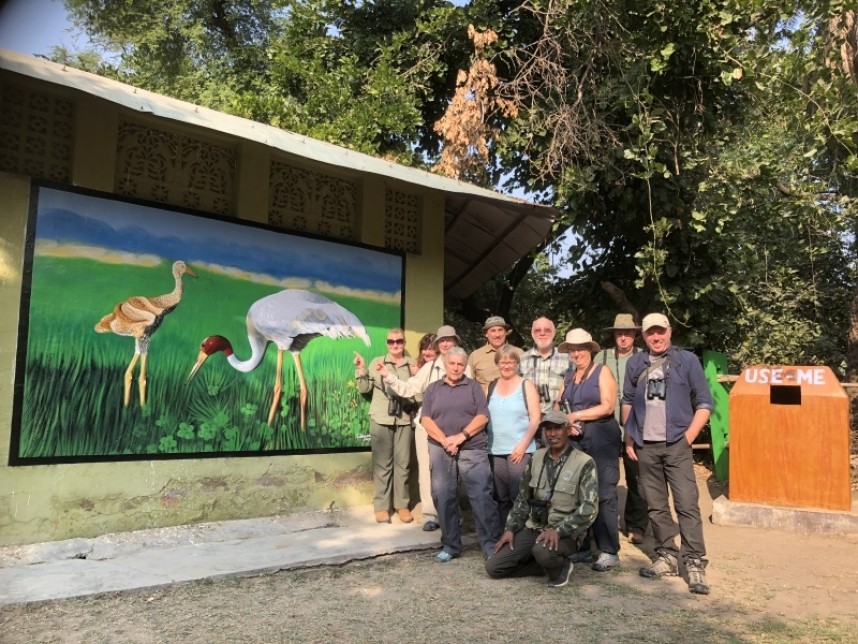
Our wonderful group of clients at Keoladeo NP © Steve Race
Surrounded by wildlife, large and small, bright and brown, feeling like we were only a tiny part of nature in amongst a vibrant scene of wildness was a fitting way to end our tour. We were blessed with a fantastic group of clients with a great sense of humour, amazing local expert guides in Manoj Sharma, Ashok and Brijendra Singh and great places to stay at Jungle Jims and Birders Lodge. Big thanks to everyone who made this trip so memorable especially to our clients who made this such a great trip for Steve and I.
Richard Baines
Yorkshire Coast Nature



 Back to Blog
Back to Blog
